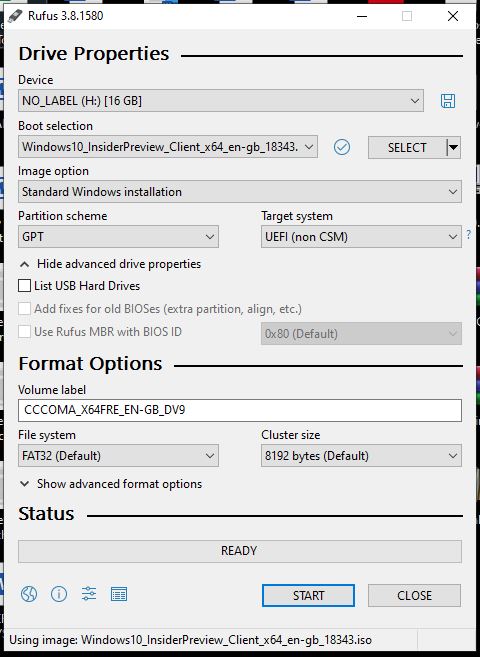

- #Rufus usb installer install
- #Rufus usb installer 64 Bit
- #Rufus usb installer 32 bit
- #Rufus usb installer upgrade
- #Rufus usb installer full
With this Live system, you can easily give Debian a try, and also test how well Debian interacts with your hardware.Īnd then there is the Calamares installer, an end-user-friendly alternative to our good old debian-installer, to install Debian on your harddisk. They can start the usual debian-installer from the boot menu, but their main goal is the Live system, which starts a real Debian system directly from the iso image, without installation on your harddisk.


Please refer to the Firmware Page for details.Īlternatively to the installation images mentioned above there are Live install images available. Since bookworm, non-free firmware is allowed to be included in the official installation media, so firmware should be no problem anymore for installation. The additional images are optional and include extra packages, that can be downloaded individually during the installation, or later.
#Rufus usb installer full
These images are for those who need all available packages that are in the current " stable" release of Debian.Īlthough there are over 30 CDs (or 5 DVDs) in a full set, only the first CD or DVD is required to install Debian. If you have no way of establishing a network connection while installing then you will need to install using at least a partial set of the installation CDs or DVDs (at least Disc 1). In any case it may be preferable to install with a wired connection for bandwidth reasons or simply to defer wireless setup until after the initial installation. If your wireless network card is not recognized by the installer you might consider performing the installation using a wired (Ethernet cable) connection or installing using a different network card. A netinst ISO image is several hundred MB but the CD or DVD images are much larger and will almost surely contain packages which are downloaded but not installed by default. During installation as many packages as you request are downloaded from the Internet. This network install ISO (called "netinst") contains only a near-minimal Debian system. There are two main choices of installation media to meet your needs:įor those with reliable Internet access using a network install image often saves time, compared with downloading some of the 650 MB ISO images.
#Rufus usb installer 64 Bit
The amd64 architecture is for both Intel and AMD 64 bit CPUs.) The amd64 architecture is appropriate for most common hardware.
#Rufus usb installer 32 bit
(The i386 architecture is for both Intel and AMD 32 bit CPUs.
#Rufus usb installer upgrade
If you want to install Unstable, download the image for Stable and upgrade through Testing to Unstable by editing /etc/apt/sources.list.Ĭhoosing The Appropriate Installation Mediaīe sure you have downloaded the installer for your hardware architecture. There are currently no network install images for Unstable. If it is important to you to have the absolute latest packages available in Debian, you should learn about Debian " Unstable". If timely and official security updates are of any importance to your use case, do not migrate to Unstable. The Debian Security Team only maintains security updates for the current "stable" release. Unstable exclusively gets security updates through its package maintainers. The network install images for testing (trixie) can be found at. If it is important to you to have recent packages of all the installed software continuously rolling through Debian, and you are fine with constantly downloading and installing updates that will stir up a bug at times, and you want to help squash bugs threatening to get into Stable, you may choose Debian " Testing". The network install images for stable (bookworm) can be found at In most cases, when people talk about Debian, they are referring to Debian "Stable". Choose Debian " Stable" if you want the computer to just work for a prolonged period of time, without the risk of new packages breaking your habits or workflow. Debian chose stability, as administrators needed for servers. The whole point of Debian from day one was "Stable", in reaction to what else was extant at the time: SoftLandingSystems " SLS" and Slackware. Refer to Debian Releases for more information about the Debian versions, but the following ideas may guide your decision. Creating a Bootable Debian USB Flashdrive.Choosing The Appropriate Installation Media.


 0 kommentar(er)
0 kommentar(er)
